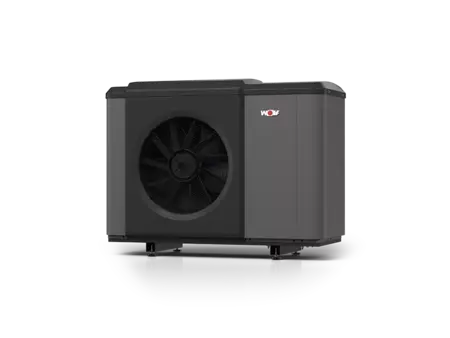
SPF of heat pumps
The most important figure for assessing the efficiency of heat pumps
The seasonal performance factor − abbreviated as SPF − is a crucial indicator of the efficiency and performance of heat pumps. You need to know the SPF value to be able to determine the efficiency of your heating system. This article will tell you what you need to consider.
What exactly is the SPF?
The seasonal performance factor provides information on how efficiently the entire heating system of your house works. It compares the heat generated over the course of a year with the electricity used to do so. This factor is essential for evaluating the performance and efficiency of heat pumps. However, the total efficiency not only depends on the appliance used, it is also influenced by the particular operating conditions. For this reason, is cannot be defined in general terms and is usually not listed in the specification data sheets. Nevertheless, it is relatively simple to calculate the SPF of your heat pump.
Find a WOLF installer near you now who can help you to determine the efficiency of heat pumps.
Calculating the seasonal performance factor
Use the following formula to calculate the SPF of your heat pump:
SPF = generated heating energy per year (kWh/a) / electricity consumed to generate heat (kWh/a)
To calculate this value precisely, you need to know the amount of heating energy generated and the amount of electricity consumed. To find the first value, you need a heat meter that records the amount of heat delivered to the heating and DHW system. The second value indicates how much electricity your heat pump consumes. As your domestic electricity meter measures the total amount of electricity consumed, you will need a separate electricity meter that only records the power consumed by your heat pump in addition to the heat meter. So you can only determine the SPF if you have access to a heat meter and electricity meters to record the values.
Example of calculating the SPF of a detached house
In our example, the house has a heating demand of 7500 kWh per year, which is covered by a water-to-water heat pump. The pump consumes 1500 kWh of electricity per year. If we apply the formula as given above, we get a seasonal performance factor of 5.0:
7500 kWh(a) / 1500 kWh(a) = SPF 5.0
But what does this value tell us? Is it good or bad? Generally speaking, the higher the SPF, the more efficiently a heat pump works.
CHA monoblock
Modern WOLF air-to-water heat pump
The WOLF CHA monoblock heats your building with outstanding efficiency at a low cost. This flexible unit can be easily installed wherever you wish.

What factors affect the SPF?
The seasonal performance factor not only takes into account a fixed efficiency value for your heat pump, it also factors in different operating states. These vary over the course of a year because the operating conditions change from season to season. The type of heat pump used is also significant. For example, if the heat pump draws energy from a geothermal source, seasonal temperature fluctuations have less of an effect than they do on air-to-water heat pumps.
The SPF is mainly influenced by the following factors:
- Heating system flow and return temperatures
- Type of heat source used for the heat pump (water, air, geothermal)
- Building insulation condition and associated heat losses
- Personal heating habits
As we can see, the seasonal performance factor is not set in stone but instead depends on the respective underlying conditions. But this also means that you can tweak this coefficient of performance.
The better the building is insulated and the more economical your heating habits, the lower the heat losses will be and the correspondingly more efficient your heating system. VDI guideline 4650 outlines some of these factors to improve the comparisons of heat pump heating systems. However, further factors, such as ventilation and heat pump settings also affect the SPF and are not included in the guideline.
Difference between SPF and COP
You will often see the abbreviation COP when buying a heat pump. It stands for coefficient of performance and is another crucial figure required to assess the efficiency of heat pumps. The COP is also based on the ratio of generated thermal energy to consumed electricity but is calculated in a different way to the SPF.
The COP can only ever reflect a certain current status while the SPF records efficiency over the course of an entire year. Furthermore, the COP of a heat pump always references a fixed leaving water temperature.
All in all, the COP is considered to be less informative than the seasonal performance factor for assessing the efficiency of a heat pump. On the other hand, the COP can usually be found on the specification data sheet and can be used to compare the basic efficiency of different appliances. However, the COP is calculated using unchanging conditions that are unlikely to occur in the real world.
The SPF shows that modern heat pumps are efficient
To assess whether converting your heating system to a heat pump heating system would be worthwhile, you must include factors such as acquisition costs, operating costs and economic efficiency. Heat pumps use free environmental heat to supply thermal energy to your heating system. They run on very little energy.
Heat pumps provide free and emission-free environmental energy but still require some electricity to operate. But contrary to common assumptions, they consume very little power.
The following example shows the potential cost of the electricity needed to operate a heat pump:
- If we take a building with a heating demand of 6000 kWh per year, an air-to-water heat pump with an SPF of 4.1 would consume approx. 1463 kWh of power over the same period.
- If the electricity price starts at 30 cents per kilowatt hour, the heating costs would start at 438 euros.
- Under the same conditions, a brine-to-water heat pump with an SPF of 4.75 would only consume 1263 kWh per year, which would reduce the cost of heating.
Even in times of rising electricity prices, the cost of heat pump heating systems is significantly lower than that of gas heating or oil heating systems, especially as fossil fuels are also rocketing in price. If you generate either part or all of the electricity needed to run the heat pump using a photovoltaic system, heating is cheaper still.
How do you find the heat pump that best suits your needs?
As heat pumps do not rely on fossil fuels, they are a climate-friendly and cost-effective heating technology. To select the right model for you, you not only need to know the seasonal performance factor but also other conditions that affect your building and heating habits. So we would always recommend that you seek specialist advice.

Top advice from WOLF
If you are looking for an efficient heat pump for your existing building or a new build, you should seek in-depth advice. Correct dimensioning and careful planning are crucial for efficient heating. The experts at WOLF will be happy to help you.
The seasonal performance factor is an indispensable performance figure
General statements on the economic efficiency of heating systems are always problematic because the individual conditions are also significant. Building insulation, heating habits and leaving water temperatures are just a few of the factors that affect the efficiency of a heat pump.
For this reason, it is important to know not only the COP but also the SPF when comparing heat pump systems. The seasonal performance factor allows you to estimate operating costs on an individual basis. The SPF is also useful for assessing the actual economic efficiency of an appliance over longer periods of time in ongoing operation.


